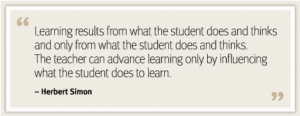Does a Shift Toward Active Learning Mean the End of the Lecture?
November 1, 2016
Author and professor Richard Gunderman defends the place of the lecture in higher education in a brief article entitled “Is the Lecture Dead?” For Gunderman, the purpose of the lecture is not to convey information as quickly as possible with minimal student engagement, but to engage student imaginations and inspire enthusiasm for select subject matters. Gunderman observes that the lecture is often singled out as the “prototypically old school, obsolete learning technology” by those who favor interactive formats and newer educational technologies.He correctly discerns that not all new technologies “enliven” the classroom and that some types of small group work can be as “deadening” as the lecture is assumed to be. Gunderman also seems to imply that it is not the educational tool but the user who matters, offering instead the critical provocation that the format of the lecture is not the problem but the fact of bad lecturers. He provides examples of lecturers who keep their audiences engaged (Randy Pausch, Steve Jobs) contending that great lecturers can just as equally provide “transformative educational experiences.” To do away with the lecture, Gunderman concludes, “would be a grave error.”

I appreciate Gunderman’s desire to use the lecture format to “engage the human spirit.” However, I think his article is representative of some misconceptions about active learning. Gunderman is correct that the user matters when it comes to educational tools and their implementation. A fundamental misconception throughout the article is the focus on the tool user: the instructor. Here, it is the lecturer/speaker’s responsibility to convey information in a way that inspires, engages, and stimulates questions and devotion to the subject matter. The essential difference between Gunderman’s perspective and principles of active learning is a shift in focus from the lecturer/instructor to the student learner. For instance, Gunderman contends that great lecturers can help students learn and discover new meaning. However, this places the responsibility for student learning solely on the lecturer. In contrast, principles of active learning challenge instructors to take a collaborative approach, arguing that instructors must direct attention to the way students learn, and to encourage students to take an active role and responsibility in the learning process.

The Eberly Center at Carnegie Mellon University opens their webpage on the “Principles of Teaching and Learning” with a quote from Herbert Simon: “Learning results from what the student does and thinks and only from what the student does and thinks.” The Eberly Center recommends acquiring and using knowledge about students/learners to inform course and classroom design. The structure of the course comes not only from the information the instructor believes is pertinent to the subject matter but also from clearly articulated Intended Learning Outcomes (ILOs). Similarly, activities created to support specific learning objectives and assessments are not used to measure the amount of information students have ingested, but instead, should provide opportunities for students to demonstrate knowledge and practical skill sets. ILOS, instructional activities, and assessments must be aligned with explicit expectations for their fulfillment. At every step, the focus remains on what the instructor expects students to be able to do and providing opportunities for students to practice what they have learned.
It is a misconception that proponents of active, student-centered learning want to do away with the lecture. Instead, the Eberly Center asks instructors to carefully consider what approach and instructional capacity will best facilitate the learning outcomes for their respective lessons and courses. A 2012 article entitled “Twilight of the Lecture” begins with the attention grabbing statement that the trend toward active learning “may overthrow the style of teaching that has ruled universities for 600 years.” Perhaps this is true, but I tend to think of active learning as a return to the original intention of universities: to educate. A learner-centered perspective simply brings to the forefront what should have been the focus all along: namely, how to guide students in a process that leads to long term change in their views of the world, their attitudes, their beliefs, and their behaviors (Ambrose, et al. 3).
Works Cited:
- Ambrose, Susan., et al. How Learning Works: 7 Research-Based Principles for Smart Teaching. San Francisco: Wiley & Sons, 2012. Print.
- Gunderman, Richard. “Is the Lecture Dead?” The Atlantic. 29 Jan 2013. Web. 24 July 2016.
- Lambert, Craig. “Twilight of the Lecture.” Harvard Magazine. March/April 2012. Web. 23 July 2016.
- “Principles of Teaching and Learning.” Eberly Center: Teaching Excellence and Educational Innovation. Carnegie Mellon University. 2008, 2012. Web. 23 July 2013.

